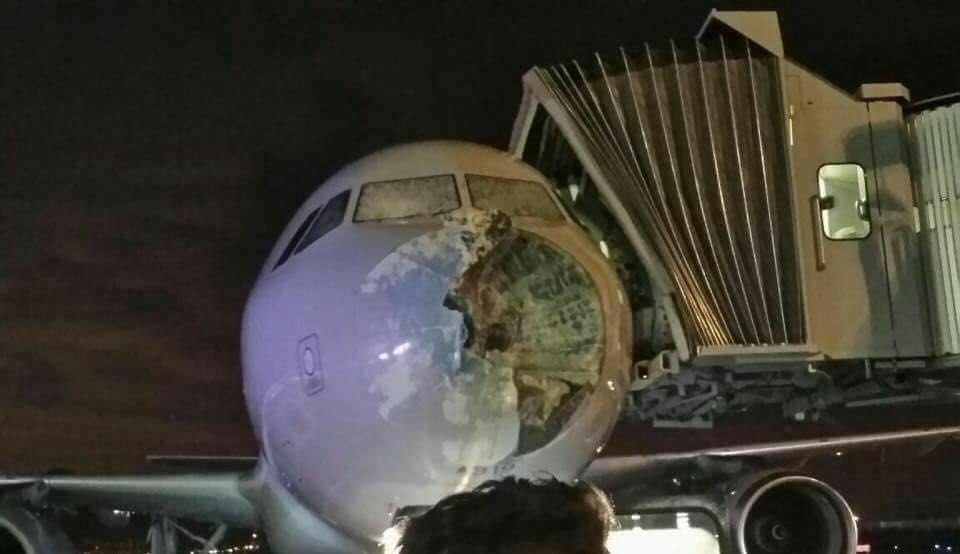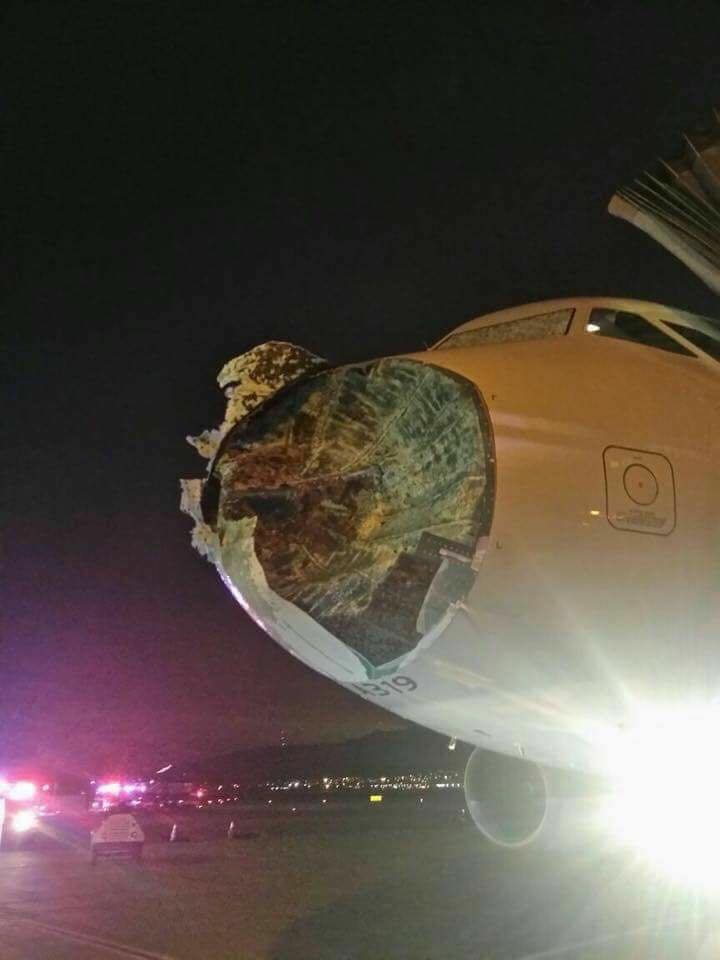[All images below are credited to Holly Rush]
Last night American flight 1897 from was flying from San Antonio to Phoenix when they encountered a massive, tall thunderstorm. Per reports from ABC, CBS, and Reuters, passengers could see lightning outside the windows (although lightning strikes aren’t THAT uncommon in commercial flight) and there was severe turbulence.
Suddenly flight 1897 experienced a severe hail strike, damaging the nose cone of the Airbus A319 and damaging the windshield.
Before I show you the pics, the reason I’m writing a post about this is to celebrate the work of the flight crew, who calmly descended from 34000 feet to 9000 feet, burned off some fuel, and landed in El Paso just over an hour after taking off from San Antonio.
Note: the flight crew made this emergency landing with basically no forward visibility.
American sent a 737 to pick up the passengers and the flight arrived in Phoenix safely with only a 3-hour delay.
This was no doubt a tense time for passengers but stories like this show just how experienced airline crews are today. Air travel has never been safer than it is today, partly due to technology but also due to calm, cool, and collected flight crews like the one who safely landed the wounded bird last night. My hat is off to you and the thousands of other airline crews who would’ve landed just as safely!
Holly Rush took some pictures, below, of the affected aircraft that put the urgency of the situation into a real context for me.





Hi Andy
I’m an (ex) corporate and airline captain as am obviously a proponent of my colleagues who work extremely hard and professionally day in day out in challenging conditions.
Umm.. but there’s rarely an excuse for flying into a monster thunderstorm like one that caused that. Sometimes both (Left and right) radars have a common problem but pretty unlikely.
I’d say they did a fantastic job in actually controlling the airplane while in the storm and of course then putting it on the deck. But… how about not flying into that weather, you gotta go round it, or in the very very worst case scenario even turn back.
Just my professional opinion -albeit of course without all the facts. And I do admire your positivity Andy.
Is it possible for the adverse weather event like hail to develop suddenly?
Based on the description, the plane was already at cruising altitude, would they have enough fuel to fly around it?
Would love to understand how decisions are made whether or not to fly through vs. around
I’ve reached out to an air traffic controller I know to see if he’d be comfortable going on the record about events like this.
Agreed, it would’ve been much better to fly around but I’m curious if the size of the storm (from northern Mexico all the way up to Oklahoma) would’ve prevented a rerouting due to fuel concerns or if they flat didn’t know the storm was as tall as it was. You probably know better than I do but I wonder if the height of the storm rapidly increased before they could reroute around it and they tried to push through instead of flying along the storm line for the distance it would take to turn around or back.
If you go to flightaware.com and input flight number, you can see where they clipped a level 5/6 cell Can also see where they had a better route flying just South of Ft Stockton and then direct ELP. Maybe dispatch is the blame. In the end, the Pilot in Command is the sole responsibility…
My reaction to this is, look at the durability of safety when traveling in a modern airplane.
No visibility. Hit by a “hailstorm” of projectiles… (it must have sounded terrible in the cabin). And the plane still landed safely.
I don’t know if this is hero status, versus standard operating procedure of a job well done.
Regardless, I’m interested because some or my family members get the jitters while flying. And this is another scenario which would be scary, yet survivable (although, I still may not bring it to their attention!) Thanks for sharing.
“These pictures were taken after landing at El Paso. Again, if someone knows the source please let me know”
So you are saying that you found some pictures and just took them from the Internet? How would you like it if some took one of your articles and used in their blog with or without credit? You do know that who ever took those pictures has a copyright on them?
I’m very well aware of it John, it happens with my pictures all the time.
I listened to the entire landing and ground conversation. The pilot had ground crews check out the damage. Ground crew said plane was fine except for windshield. I think these are from another incident.
http://kfoxtv.com/news/local/severe-weather-forces-american-airlines-flight-1897-to-divert-to-el-paso
Celebrate the successful landing. Congratulate the crew on a job well-done. But label the incident “heroic”? Please, no. Can we stop overusing that word and recognize our real heroes when appropriate
I’ve been flying for 37 years and this is an example of bad judgement from the beginning. There is NO excuse for flying into or near this kind of weather. No one needs to reach their destination bad enough to fly in or near thunderstorms.
Great job with an autoland after this scary disaster.
Those are my pictures. All the other news sources have credited me. I also have others and better ones.
So I personally know the first officer on this flight. The storm developed supernaturally underneath them. They did everything they could to get away from it. Their radar on the 319 doesn’t see down. The weather service has issued statements on this storm because they have never seen a storm develop so quickly. It was also much more that just damage to the outside of the aircraft, airspeed indicator were off, instrumentation was malfunctioning, they were manually flying an aircraft that isn’t designed to be flown manually. They landed with an obstructed 3″ view of the runway. The calm and collected actions of these pilots to save the lives of everybody on board while dealing with circumstances completely outside of their control, yeah that makes them heroes! Thanks Andy for realizing that.
Those without the facts are proved more professional by not commenting on what they don’t actually know. How much experience you have matters not.